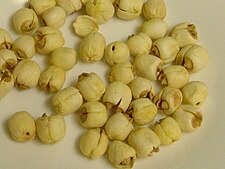Lotus seed
This article needs additional citations for verification. (August 2017) |
| Lotus seed | |||||||||||||||
|---|---|---|---|---|---|---|---|---|---|---|---|---|---|---|---|
 Dried lotus seeds as they are commonly found in the market | |||||||||||||||
| Traditional Chinese | 蓮子 | ||||||||||||||
| Simplified Chinese | 莲子 | ||||||||||||||
| Hanyu Pinyin | liánzǐ | ||||||||||||||
| Jyutping | lin4 zi2 | ||||||||||||||
| Literal meaning | lotus seed | ||||||||||||||
| |||||||||||||||
A lotus seed or lotus nut is the seed of a plant in the genus Nelumbo, particularly the species Nelumbo nucifera. The seeds are used in Asian cuisine and traditional medicine. Mostly sold in dried, shelled form, the seeds contain rich contents of protein, B vitamins, and dietary minerals.
Types


Two types of dried lotus seeds can be found commercially; brown peel and white. The former is harvested when the seed head of the lotus is ripe or nearly ripe and the latter is harvested when the seed head is still fully green but with almost fully developed seeds. White lotus seeds are de-shelled and de-membraned. At harvest, the bitter-tasting germ of most seeds is removed using a hollow needle. Brown peel lotus seeds are gross brown because the ripened seed has adhered to its membrane. The germ of these hard seeds is removed by cracking the seeds in half.
Dried lotus seeds past their prime oxidize to a yellow brown color. However, some sellers of dried lotus seeds bleach their products with hydrogen peroxide, sodium hydroxide, or other chemicals.[citation needed]
Nutrition
In a 100 gram reference amount, dried lotus seeds supply 332 calories and contain 64% carbohydrates, 2% fat, 15% protein, and 14% water.[1] The seeds contain B vitamins in rich content, particularly thiamin at 43% of the Daily Value (DV), and numerous dietary minerals, such as manganese (116% DV) and phosphorus (63% DV).[1]
Uses
The most common use of the seed is in the form of lotus seed paste (蓮蓉), which is used extensively in Chinese pastries as well as in Japanese desserts.
Dried lotus seeds must be soaked in water overnight prior to use. They can then be added directly to soups and congee or used in other dishes. Fresh lotus seeds are sold in the seed heads of the plant and eaten by breaking the individual seeds out of the cone-shaped head and removing the rubbery shell. Crystallized lotus seeds (蓮子糖), made by drying lotus seeds cooked in syrup, are a common Chinese snack, especially during Chinese new year.
Lotus seeds are also common in the northern part of Colombia, especially in cities like Barranquilla and Cartagena. Locals usually refer to lotus seeds as "martillo." Fresh lotus seeds are sold in street markets and are generally eaten raw by the locals.
Traditional medicine
When cooked in clear soups, lotus seeds are believed to "clear heat" (清熱) and be nutritious, which may explain their prevalence in Chinese cuisine.[citation needed]
See also
References
- ^ a b "Lotus seeds, dried, per 100 g (from pick list)". Nutritiondata.com for the USDA National Nutrient Database, version SR-21. 2014. Retrieved 9 January 2018.
